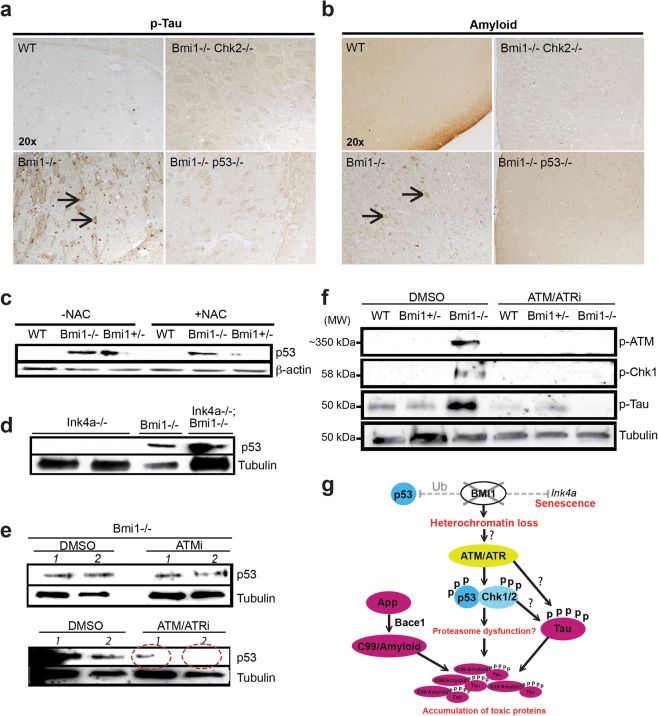Figure 6.
Blocking the DDR mitigate the amyloid and Tau phenotype in Bmi1-null neurons. (a,b) IHC performed on cortical sections from 25 day-old mice. (a) Arrows indicate p-Tau-positive neurons in Bmi1−/− mice. (b) Arrows indicate amyloid-positive neurons in Bmi1−/− mice. These anomalies were largely prevented in the double-mutant mice. (c–f) Immunoblot were performed on embryonic day 18.5 mouse cortical neurons cultured for 7 days in vitro. (c–d) Addition of NAC or co-deletion of Ink4a could not prevent p53 accumulation in Bmi1-deficient neurons. Note the presence of p53 also in Bmi1+/− neurons. NAC was added daily to the cultures for a period of 7 days. (e,f) DMSO, ATMi or ATM/ATRi were added to the cultures 16 hours prior to protein extraction. (e) ATM/ATRi largely prevented p53 accumulation in Bmi1−/− neurons. Numbers 1 and 2 in (e) indicate two independent biological replicates. Note residual p53 expression in ATM/ATRi-treated neurons (circles with dash lines). (f) Addition of ATM/ATRi could prevent p-ATM, p-Chk1 and p-Tau accumulation in Bmi1−/− neurons. (g) Hypothetical model to explain the impact of Bmi1 inactivation in mouse neurons. Following loss of Bmi1, up-regulation of the Ink4a locus induces neuronal senescence. On the other hand, genomic instability at the heterochromatin induces a chronic DDR. The p53 protein is then stabilized by ATR/ATM-mediated kinase activity. The accumulation of p53 may be also exacerbated by the loss of Bmi1/Ring1a-mediated ubiquitin ligase and antioxidant activities. The activated ATM/Chk2, ATR/Chk1 and p53 pathways then promote Tau phosphorylation and accumulation of the C99 fragment. Elevated Bace1 levels also contribute to over-production of the C99 fragment. Accumulation of these toxic proteins contributes to neurodegeneration.

